A least tern protects one of its chicks in a nesting colony on the beach. (Courtesy Kevin Knutsen)
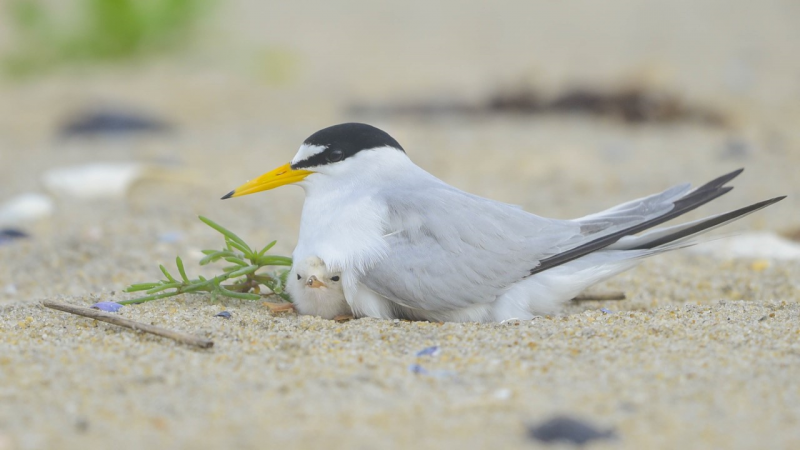 By Donald Wittkowski
By Donald Wittkowski
In the wild, when you’re small, you tend to get picked on by the bullies.
Least terns, a tiny shorebird, must contend with crows, seagulls, foxes, raccoons, opossums and skunks raiding their nests and eating their chicks.
Domestic animals are also a lethal threat to the terns. Cats and dogs will ravage their nesting grounds while looking for a quick meal.
“Dogs run through the colony, tear it up with their digging and then eat everything,” lamented Christina Davis, a wildlife ecologist with the New Jersey Department of Environmental Protection’s Endangered and Nongame Species Program.
In a nutshell, that explains why “No Dogs” signs are prominently displayed on the sandy walkways heading to a roped-off section of beach at the foot of the Townsends Inlet Bridge in the southern tip of Sea Isle City.
Contrasting with the pristine tourist beaches where Sea Isle’s sunbathers relax under their umbrellas and cabanas, this scruffy stretch of sand off 94th Street is littered with seashells and overgrown dune grass. But it is an important part of the shore’s ecosystem.
The area, intentionally left in its natural state, serves as a state-managed refuge for the endangered least terns as they struggle to raise their chicks amid constant threat from so many intruders.
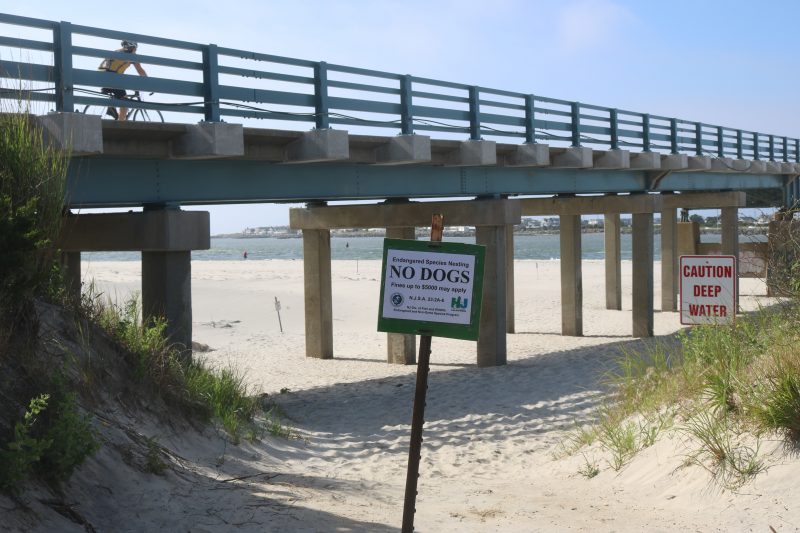
A "No Dogs" sign warns owners to keep their pets out of the least tern nesting area at the base of the Townsends Inlet Bridge.
Davis, who oversees the nesting area, noted that she spotted a crow that had invaded the terns’ territory on Friday morning.
“They’ll eat the eggs and chicks. They’re a major predator that we have,” she said of the crows.
In New Jersey, the least terns are classified as an endangered species, which Davis stressed is “pretty serious.”
“We are concerned that they will disappear from New Jersey,” she said.
The refuge in Sea Isle is one of a series of Department of Environmental Protection-supervised nesting areas along the New Jersey coast designed to help shorebirds that are under pressure from predators and loss of habitat, including least terns, American oyster catchers, piping plovers and black skimmers.
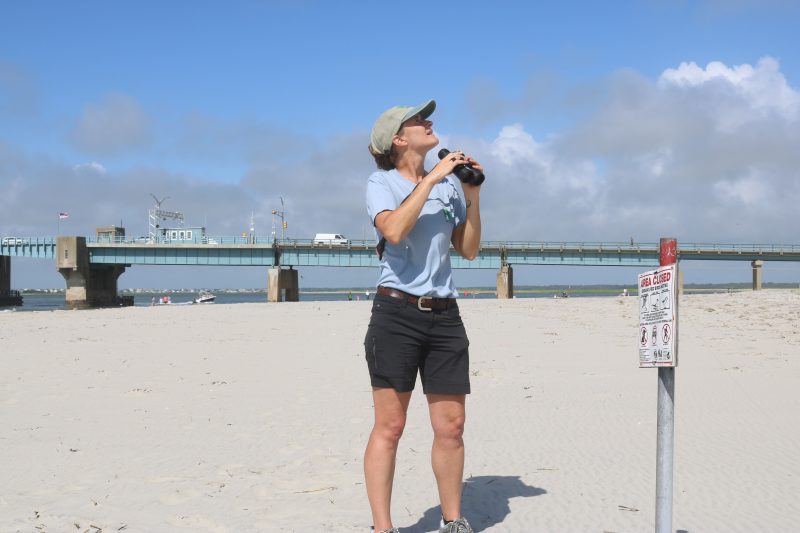
Christina Davis, a state wildlife ecologist who supervises the nesting colony, gazes up at some least terns flying overhead.
Least terns, the smallest of the tern species, have their nesting season between early May and late August. After spending their summers at the New Jersey shore, the terns migrate to North Carolina, the Gulf Coast and as far away as South America, Davis said.
During breeding season, their plumage is distinguished by a black crown ending at their white forehead. Grayish in color on top, the birds have a bright white underbelly and pointed wings. Their yellow beaks are another notable feature.
Least terns dive-bomb the churning waters of Townsends Inlet to catch minnows and tiny silversides fish that serve as food for their chicks.
At the terns’ colony in Sea Isle, the air is filled with the noisy chirps of birds frantically flying back and forth between the inlet and their nests.
When they’re not flying directly overhead, the birds can be observed from a distance. The colony remains roped off to keep human trespassers from disturbing the nests and chicks.
Davis said she occasionally must repair or replace ropes that are removed or cut down by people. She also spends time putting back the “No Dogs” signs that are taken down by people almost every day.
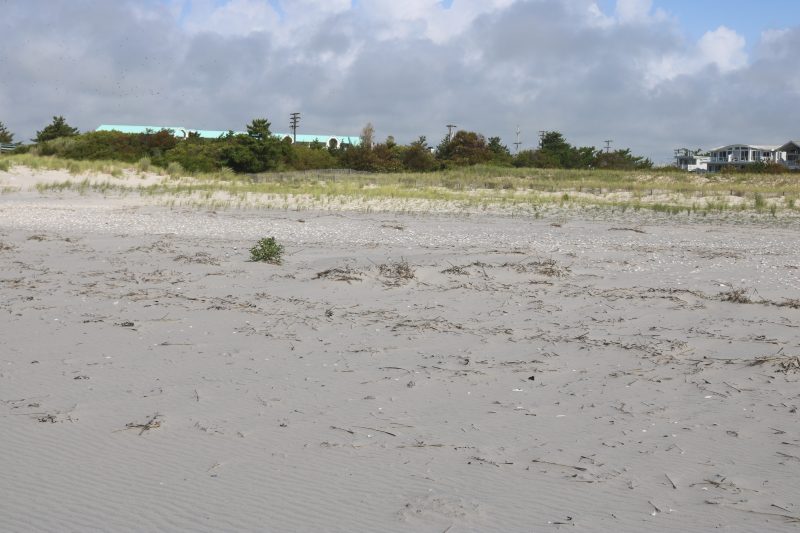
The Townsends Inlet beach that serves as the nesting area is left in its natural state, including overgrown dune grass and seashells littering the sand.
Human interference only adds to the myriad hazards that least terns face in the wild. This nesting season has been “terrible” for the terns, mostly because of the abundance of predators, Davis pointed out.
“This colony has done very poorly this year,” she said. “If this was a success, we would have birds all over the place. We’ve had only a handful of chicks fledge this year.”
Other summers, though, have been a banner year for the terns, Davis said. Like nature itself, the nesting seasons are unpredictable.
“Last year, they had an OK year,” Davis said. “One year it will be amazing and the next year it will tank.”
On Friday, bird watcher Rich Bonnet stopped by the nesting area like he does every summer while vacationing in Sea Isle from his home in Reading, Pa.
Bonnet, who took photos of the terns, marveled at how the small birds are able to survive amid so many challenges in the wild. Least terns can live into their 20s.
“I like all birds,” said Bonnet, a member of the Baird Ornithological Club in Reading. “These particular birds are so threatened, so my sympathy goes out to them.”
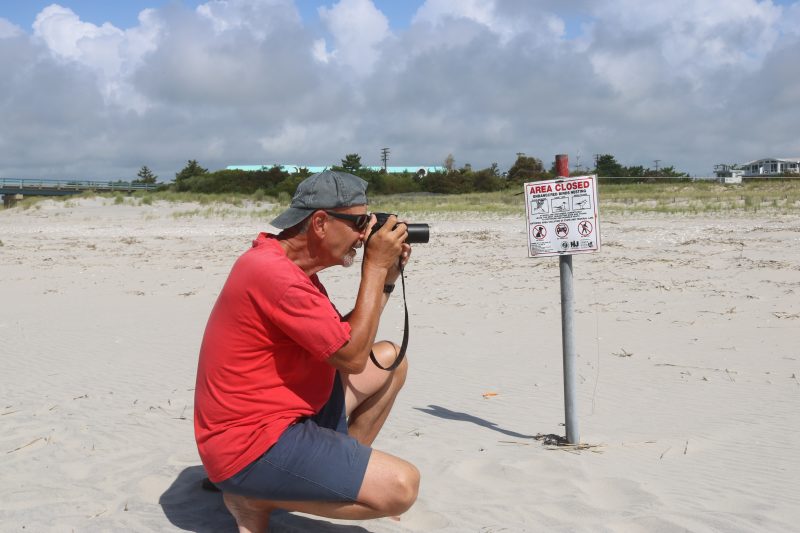
Bird watcher Rich Bonnet, a vacationer from Reading, Pa., takes photos of the nesting least terns from a safe distance.
 By Donald Wittkowski
In the wild, when you’re small, you tend to get picked on by the bullies.
Least terns, a tiny shorebird, must contend with crows, seagulls, foxes, raccoons, opossums and skunks raiding their nests and eating their chicks.
Domestic animals are also a lethal threat to the terns. Cats and dogs will ravage their nesting grounds while looking for a quick meal.
“Dogs run through the colony, tear it up with their digging and then eat everything,” lamented Christina Davis, a wildlife ecologist with the New Jersey Department of Environmental Protection’s Endangered and Nongame Species Program.
In a nutshell, that explains why “No Dogs” signs are prominently displayed on the sandy walkways heading to a roped-off section of beach at the foot of the Townsends Inlet Bridge in the southern tip of Sea Isle City.
Contrasting with the pristine tourist beaches where Sea Isle’s sunbathers relax under their umbrellas and cabanas, this scruffy stretch of sand off 94th Street is littered with seashells and overgrown dune grass. But it is an important part of the shore’s ecosystem.
The area, intentionally left in its natural state, serves as a state-managed refuge for the endangered least terns as they struggle to raise their chicks amid constant threat from so many intruders.
By Donald Wittkowski
In the wild, when you’re small, you tend to get picked on by the bullies.
Least terns, a tiny shorebird, must contend with crows, seagulls, foxes, raccoons, opossums and skunks raiding their nests and eating their chicks.
Domestic animals are also a lethal threat to the terns. Cats and dogs will ravage their nesting grounds while looking for a quick meal.
“Dogs run through the colony, tear it up with their digging and then eat everything,” lamented Christina Davis, a wildlife ecologist with the New Jersey Department of Environmental Protection’s Endangered and Nongame Species Program.
In a nutshell, that explains why “No Dogs” signs are prominently displayed on the sandy walkways heading to a roped-off section of beach at the foot of the Townsends Inlet Bridge in the southern tip of Sea Isle City.
Contrasting with the pristine tourist beaches where Sea Isle’s sunbathers relax under their umbrellas and cabanas, this scruffy stretch of sand off 94th Street is littered with seashells and overgrown dune grass. But it is an important part of the shore’s ecosystem.
The area, intentionally left in its natural state, serves as a state-managed refuge for the endangered least terns as they struggle to raise their chicks amid constant threat from so many intruders.
 A "No Dogs" sign warns owners to keep their pets out of the least tern nesting area at the base of the Townsends Inlet Bridge.
Davis, who oversees the nesting area, noted that she spotted a crow that had invaded the terns’ territory on Friday morning.
“They’ll eat the eggs and chicks. They’re a major predator that we have,” she said of the crows.
In New Jersey, the least terns are classified as an endangered species, which Davis stressed is “pretty serious.”
“We are concerned that they will disappear from New Jersey,” she said.
The refuge in Sea Isle is one of a series of Department of Environmental Protection-supervised nesting areas along the New Jersey coast designed to help shorebirds that are under pressure from predators and loss of habitat, including least terns, American oyster catchers, piping plovers and black skimmers.
A "No Dogs" sign warns owners to keep their pets out of the least tern nesting area at the base of the Townsends Inlet Bridge.
Davis, who oversees the nesting area, noted that she spotted a crow that had invaded the terns’ territory on Friday morning.
“They’ll eat the eggs and chicks. They’re a major predator that we have,” she said of the crows.
In New Jersey, the least terns are classified as an endangered species, which Davis stressed is “pretty serious.”
“We are concerned that they will disappear from New Jersey,” she said.
The refuge in Sea Isle is one of a series of Department of Environmental Protection-supervised nesting areas along the New Jersey coast designed to help shorebirds that are under pressure from predators and loss of habitat, including least terns, American oyster catchers, piping plovers and black skimmers.
 Christina Davis, a state wildlife ecologist who supervises the nesting colony, gazes up at some least terns flying overhead.
Least terns, the smallest of the tern species, have their nesting season between early May and late August. After spending their summers at the New Jersey shore, the terns migrate to North Carolina, the Gulf Coast and as far away as South America, Davis said.
During breeding season, their plumage is distinguished by a black crown ending at their white forehead. Grayish in color on top, the birds have a bright white underbelly and pointed wings. Their yellow beaks are another notable feature.
Least terns dive-bomb the churning waters of Townsends Inlet to catch minnows and tiny silversides fish that serve as food for their chicks.
At the terns’ colony in Sea Isle, the air is filled with the noisy chirps of birds frantically flying back and forth between the inlet and their nests.
When they’re not flying directly overhead, the birds can be observed from a distance. The colony remains roped off to keep human trespassers from disturbing the nests and chicks.
Davis said she occasionally must repair or replace ropes that are removed or cut down by people. She also spends time putting back the “No Dogs” signs that are taken down by people almost every day.
Christina Davis, a state wildlife ecologist who supervises the nesting colony, gazes up at some least terns flying overhead.
Least terns, the smallest of the tern species, have their nesting season between early May and late August. After spending their summers at the New Jersey shore, the terns migrate to North Carolina, the Gulf Coast and as far away as South America, Davis said.
During breeding season, their plumage is distinguished by a black crown ending at their white forehead. Grayish in color on top, the birds have a bright white underbelly and pointed wings. Their yellow beaks are another notable feature.
Least terns dive-bomb the churning waters of Townsends Inlet to catch minnows and tiny silversides fish that serve as food for their chicks.
At the terns’ colony in Sea Isle, the air is filled with the noisy chirps of birds frantically flying back and forth between the inlet and their nests.
When they’re not flying directly overhead, the birds can be observed from a distance. The colony remains roped off to keep human trespassers from disturbing the nests and chicks.
Davis said she occasionally must repair or replace ropes that are removed or cut down by people. She also spends time putting back the “No Dogs” signs that are taken down by people almost every day.
 The Townsends Inlet beach that serves as the nesting area is left in its natural state, including overgrown dune grass and seashells littering the sand.
Human interference only adds to the myriad hazards that least terns face in the wild. This nesting season has been “terrible” for the terns, mostly because of the abundance of predators, Davis pointed out.
“This colony has done very poorly this year,” she said. “If this was a success, we would have birds all over the place. We’ve had only a handful of chicks fledge this year.”
Other summers, though, have been a banner year for the terns, Davis said. Like nature itself, the nesting seasons are unpredictable.
“Last year, they had an OK year,” Davis said. “One year it will be amazing and the next year it will tank.”
On Friday, bird watcher Rich Bonnet stopped by the nesting area like he does every summer while vacationing in Sea Isle from his home in Reading, Pa.
Bonnet, who took photos of the terns, marveled at how the small birds are able to survive amid so many challenges in the wild. Least terns can live into their 20s.
“I like all birds,” said Bonnet, a member of the Baird Ornithological Club in Reading. “These particular birds are so threatened, so my sympathy goes out to them.”
The Townsends Inlet beach that serves as the nesting area is left in its natural state, including overgrown dune grass and seashells littering the sand.
Human interference only adds to the myriad hazards that least terns face in the wild. This nesting season has been “terrible” for the terns, mostly because of the abundance of predators, Davis pointed out.
“This colony has done very poorly this year,” she said. “If this was a success, we would have birds all over the place. We’ve had only a handful of chicks fledge this year.”
Other summers, though, have been a banner year for the terns, Davis said. Like nature itself, the nesting seasons are unpredictable.
“Last year, they had an OK year,” Davis said. “One year it will be amazing and the next year it will tank.”
On Friday, bird watcher Rich Bonnet stopped by the nesting area like he does every summer while vacationing in Sea Isle from his home in Reading, Pa.
Bonnet, who took photos of the terns, marveled at how the small birds are able to survive amid so many challenges in the wild. Least terns can live into their 20s.
“I like all birds,” said Bonnet, a member of the Baird Ornithological Club in Reading. “These particular birds are so threatened, so my sympathy goes out to them.”
 Bird watcher Rich Bonnet, a vacationer from Reading, Pa., takes photos of the nesting least terns from a safe distance.
Bird watcher Rich Bonnet, a vacationer from Reading, Pa., takes photos of the nesting least terns from a safe distance.